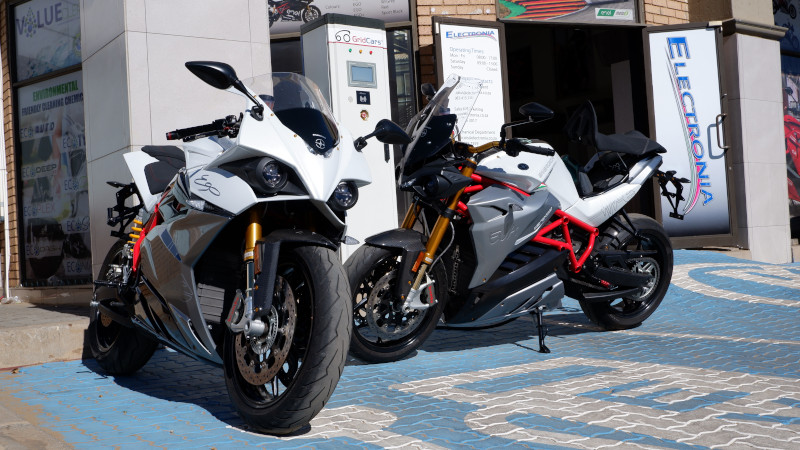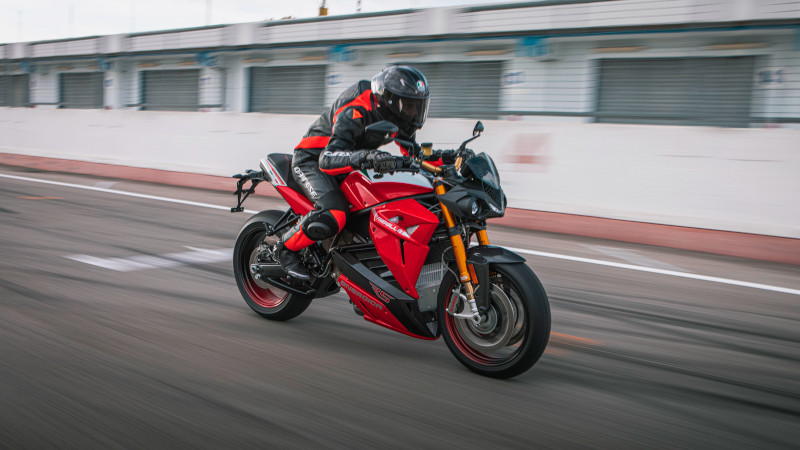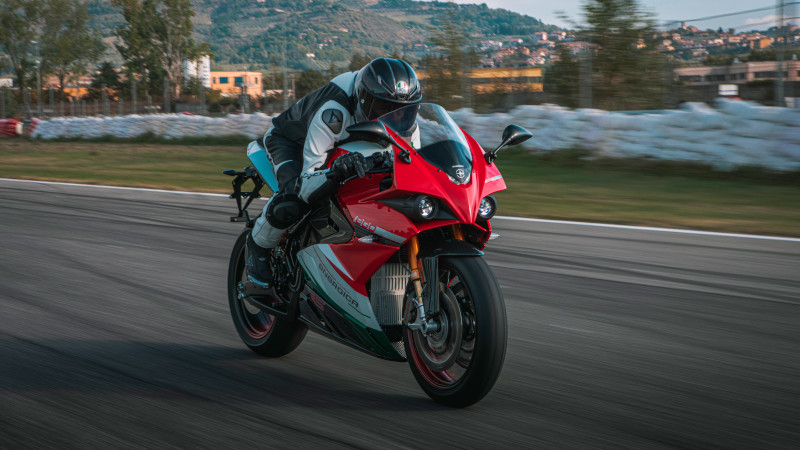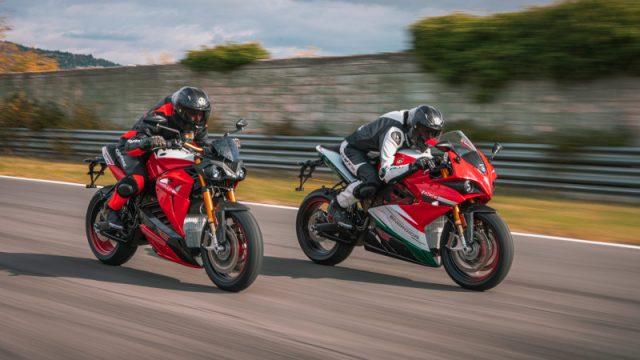On South Africa’s roads, electric motorcycles are even more of a rarity than electric cars. We sent UZAIR ABDUL-KARRIM to ride and report on Energica’s lightning-fast electric road bikes: the Ego and the Eva.
Before visiting Energica’s lair on the banks of the Vaal River, I wanted to know what I would be dealing with. So, I did some reading and came away impressed.
Energica Motor Company, which lies 12 kilometres north of Modena (not far from Ferrari HQ), has achieved a great deal since its founding in 2014. From the inception of the electric-only MotoE World Championship in 2019, Energica has supplied the racing series’ motorcycles.
To build these racers, the Italian company used the road-going Ego super bike as its foundation. This means the Energica Ego Corsa of the MotoE World Championship and the road-legal Ego are quite similar.

Because super bikes have a limited appeal of late, the Ego branched out into a naked bike, the Eva. The latter shares its chassis and drive-train with the Ego. The Eva provides a more comfortable, upright riding position, as well as the swagger big nakeds (also called “streetfighters”) usually have.
Design and appearance
The Ego and the Eva look purposeful, aggressive and exciting in ways that few electric motorcycles do. Where Harley-Davidson’s handsome LiveWire ONE won’t be mistaken for a bike that runs on petrol (let alone a typical Harley), Energica follows a different approach.
The Ego and Evo closely resemble 1 000 cc Italian performance bikes. In that sense, their styling is traditional. This should make these machines more enticing to riders who don’t have a taste for the futuristic, sci-fi styling of some electric vehicles.

Being a race replica, the Ego certainly looks the part. You could say it is the electric equivalent of a Ducati Desmosedici or BMW S1000RR HP4. These too are track-bred road bikes with racing specifications.
[mailchimp_list]
Femme fatale
The Eva is to the Ego what the Aprillia Tuono is to the RSV4, or what the Ducati Streetfighter is to the Panigale. It’s an age-old recipe. Take your top super bike, strip off the fairings, lower the pegs, and make the bars higher and wider. The performance of the faired bike remains, with some added comfort for daily rideability.

On closer inspection, you notice it goes further than just being stylish. These bikes have all the parts to match the image, such as the Brembo Stylema brake callipers, Ohlins suspension, and lashings of carbon fibre. These parts are what you see on the premium end of the sports bike market, and telling of what can be expected from the performance. (Do keep in mind that some performance parts are optional extras.)
Weight and performance
The Ego and Eva that I tested use the 13.5 kWh battery pack. Both motorcycles have been updated and now harness a 21.5 kWh battery, while the inverter and electric motor were revised. We’re told the new battery, inverter, and motor increase performance while reducing weight. The new drivetrain also provides more than double the riding range compared to the pre-facelift Ego and Eva.
The weight saving with the new battery, motor and converter is considerable, with the standard Ego (13.5 kWh) weighing in at a hefty 282 kg, while the revised Ego+ and Ego RS (21.5 kWh) weigh 260 kg each. For perspective, a fully fuelled BMW R1250GS weighs just over 250kg.
Power increases from 107 kW to 126 kW, while maximum torque jumps from 200 Nm to 215 Nm. These power gains and weight savings are shared with the Eva, but the latter is limited to 200 km/h, while the Ego has a 240 km/h top end.

Getting naked
On a Saturday morning, I met the friendly Electronia team at their head office at the Riverside Boulevard shopping Centre in Vanderbijlpark, Gauteng. After showing me how the batteries are recharged, we geared up and got ready to ride. Immediately I noticed that the bikes feel solidly put together, like something you would expect from an established, premium manufacturer.

I swung a leg over streetfighter Eva first. I’m not sure what I was expecting, but initially it felt exceedingly… normal. Sure, there’s no clutch or the sound of refined oil set alight, but the throttle is expertly calibrated, so it feels natural.
However, twist this naked bike’s right grip in anger, and all the instant torque of an electric motor becomes very apparent. It’s a very different sensation to that of a fuel-burning bike. It picks up instantly yet smoothly, carrying on in a relentless wave. It is genuinely exciting, and yes, some of that is the novelty of riding a sporty electric bike.

Easy riding
I doubt it’s something I’d ever get tired of, though. Hard pulls, even once rolling, feel as fast as a thing on two wheels can go. Is it as fast as an equivalent internal combustion motorcycle? I’m not sure, but it feels faster.
As for dynamic capability, the Eva is easy to get along with. Once you get up to speed, you’re only vaguely aware of the extra weight. Turn-in is linear and mid-corner stability is as you’d expect, never really throwing surprises at the rider.
The seating position is comfortable (as is the seat itself), and the pegs don’t put too much bend on the knee. The high, widened bars increase the comfort factor while adding leverage. This makes the bike feel lighter when navigating at slower speeds or threading through traffic.
Hold on to your Ego
The Ego is much the same in terms of power delivery, which makes sense as they carry the same running gear. The biggest difference is the riding position, which is more committed than I was expecting. The bars are low, the pegs are high, and it feels every inch a real super bike.

At speed, the riding position adds to the excitement. Under hard acceleration and around corners, the Ego feels even more planted than the Eva. However, when pushing through traffic or manoeuvring at slow speeds, the low bars and heavy steering make the weight even more apparent.
Silent and violent
Unexpectedly, what didn’t disappoint at all was the sound. Sure, there is no howl at high revs or pops and bangs on the overrun, but it isn’t as silent as I expected. The motor emits a whine that increases in pitch and volume as you open the throttle. Again, this may be the novelty, but I didn’t feel short-changed on the aural front.
As for electronic rider aids, both bikes are at the cutting edge of tech. There’s multi-level traction control, cornering ABS, rider modes (which also affect power consumption), and different levels of ‘engine braking’. As for the rest of the equipment, the suspension is top shelf fully adjustable Ohlins front and rear. They do a good job of keeping the bikes under control, but they are stiff, probably to compensate for the 280 kg weight they must keep in check.
Much the same goes for the Stylema Brembo brakes, and they work well enough to slow the bike down. Still, you are reminded that the bikes are hefty when you tug on the brake lever. Both bikes come with reverse, which makes manoeuvring in tight spots easy.
Distance to empty
The range from fully charged to empty depends on usage. Around town, a best possible range of 200 km is achievable. In urban settings, regenerative braking puts energy back into the battery when the rider coasts or brakes. On the open road, you would be lucky to see 120 km before you run out of charge. However, those stats are for the 13.5 kWh battery.

With the newer 21.5 kWh battery, the best possible range more than doubles, from 200 km to a potential 420 km (in urban conditions). The bikes’ open road range also increased, to a potential 200 km. Charging at a public DC charger takes about 40 minutes. AC charging and charging from a domestic plug take longer.

Expect to pay…
Because of what they are, these bikes have never been cheap. Lately, with the local currency as weak as a low-water bridge built from spaghetti, expect to pay even more for a new Energica motorcycle: R650 000 to R800 000. For perspective; the local list price of the Ducati Panigale V4 – 25° Anniversario Livery is R780 000, while the BMW M 1000 RR is priced from R706 400.
Conclusion and rating
These machines are exciting and involving in a way that’s at least comparable to petrol powered alternatives. They are exclusive too, and pretty enough to buy on looks alone. These won’t be the last electric bikes of this kind, but Energica has the bar high in terms of materials used, outright usability, and being truly exceptional.
Because I rode the earlier incarnations of the Ego and Eva (for this article), I’m hesitant to score them…. but I feel I have to at least try. Therefore, until I ride the updated models, I will award the Ego and Eva four out of five each.
4.0 out of 5.0 stars




























